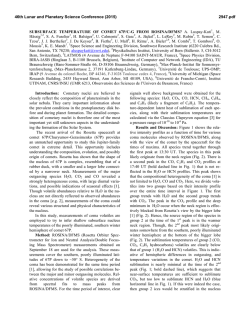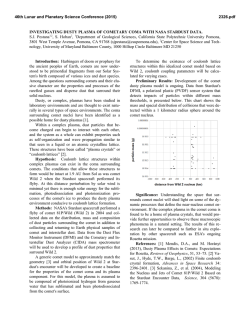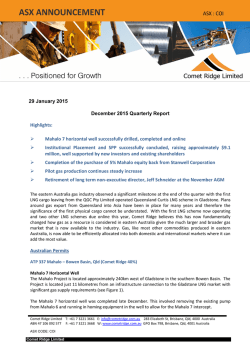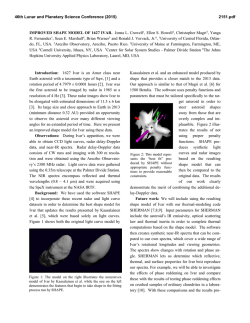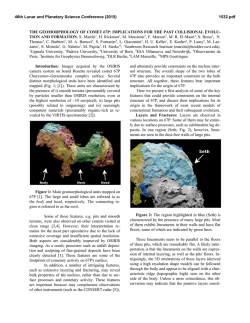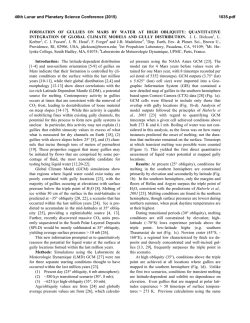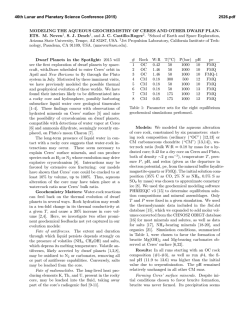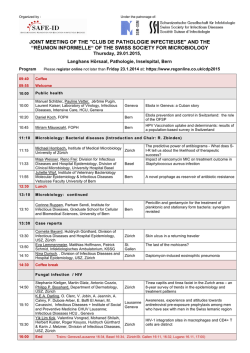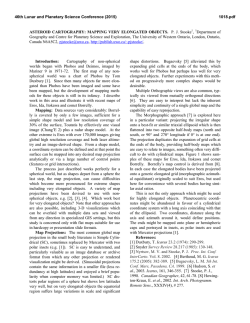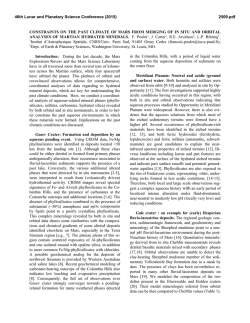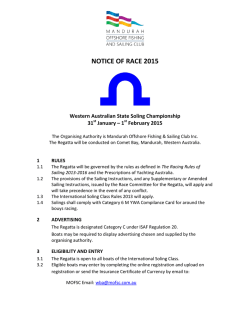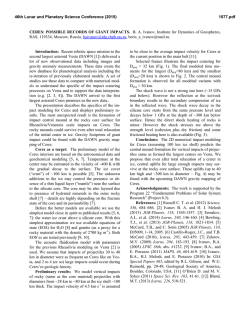
The Distribution of Gases in the Coma of Comet 67P/Churyumov
46th Lunar and Planetary Science Conference (2015) 1714.pdf THE DISTRIBUTION OF GASES IN THE COMA OF COMET 67P/CHURYUMOV-GERASIMENKO FROM ROSETTA MEASUREMENTS. M.R. Combi1, N. Fougere1, V. Tenishev1, A. Bieler1, K. Altwegg2, J.J. Bérthelier3 , J. De Keyser4, B. Fiethe5 , S. A. Fuselier6, T.I. Gombosi1, K.C. Hansen1, M. Hässig6,, Z. Huang1, X. Jia1, M. Rubin2, G. Toth1, Y. Shou1, C.-Y. Tzou2, and the Rosetta ROSINA Science Team. 1Department of Atmospheric, Oceanic and Space Science, Unibersity of Michigan, Ann Arbor, MI, [email protected]. 2Physikalisches Institut, University of Bern, Sidlerstr. 5, CH-3012 Bern, Switzerland, Belgian Institute for Space Aeronomy, 3 4 LATMOS/IPSL-CNRS-UPMC-UVSQ, 4 Avenue de Neptune F-94100 SAINT-MAUR, France, BIRA-IASB, 5 Ringlaan 3, B-1180 Brussels, Belgium, Institute of Computer and Network Engineering (IDA), TU Braunschweig, 6 Hans-Sommer-Straße 66, D-38106 Braunschweig, Germany, Southwest Research Institute, 6220 Culebra Rd., San Antonio, TX 78238, USA.. Introduction: Since its orbit insertion around comet 67P/Churyumov-Gerasimenko (CG), the Rosetta spacecraft has revealed invaluable information regarding the cometary coma environment. The extended period of observation enables a relatively extensive spatial and temporal coverage of comet CG’s coma, which showed distinct distributions for different species and activity on the surface in response to solar illumination as the nucleus rotates. Here we introduce the latest advances of a fully 3D kinetic model performed with the Direct Simulation Monte-Carlo approach applied to the cometary coma (Combi 1996) to the H2O, CO, and CO2 coma of comet CG using the Adaptive Mesh Particle Simulator code with the Rosetta nucleus shape. The model allows the description of the full coma of comet CG including the regions where collisions cannot maintain a flow that can be described by a fluid. The model is constrained by Rosetta observations giving clues regarding the gas release of the different species and the distribution of parent materials around the surface. This constitutes the most advanced coma model of comet CG, which is critical to interpret instrument data and for further mission planning. Model Analysis: As water vapor with some fraction of other gases sublimates, it generates a cloud of gas, ice, and other refractory materials (rocky and organic dust) ejected from the surface of the nucleus. The ejected material produce a large and highly variable extensive dusty coma with a size that is much larger than the characteristic size of the comet’s nucleus. During most of the Rosetta mission, the coma is under strong non-equilibrium conditions. Kinetic models based on solving the Boltzmann equation are the most appropriate tools for simulating dynamics of such environments. For simulation of the coma of 67P/ChuryumovGerasimenko we have used our Adaptive Mesh Particle Simulator (AMPS) code outlined below: • Fully kinetic description The evolution of the system is simulated by tracing the model particles • Realistic modeling of collisions in rarefied gas • Photochemical reactions for production of the minor species • Two phase simulation: gas and dust in a single model run • Adaptive mesh with cut-cells • Irregular nucleus shape for modeling the coma • Variable mesh resolution to capture important features of the dusty gas flow • Integration with SPICE • Built on an extended history of applications to other tenuous planetary atmospheres and exospheres. Cometary surface boundary conditions are based on the models of Davidsson and Gutierrez (2004, 2005, 2006) as described by Tenishev et al. (2008, 2011, 2013) and Fougere et al. (2013). This is a longterm, on-going effort, and current progress toward understanding Rosetta measurements will be described. References: [1] Combi, M.R. (1996) Icarus, 123, 207. [2] Davidsson, B.J.B & Gutiérrez, P. (2004) Icarus, 168, 392. [3] Davidsson, B.J.B & Gutiérrez, P. (2005) Icarus, 176, 453. [4] Davidsson, B.J.B & Gutiérrez, P. (2004) Icarus, 180, 224. [5] Tenishev, V. et al. (2008) ApJ, 685, 659. [6] Tenishev, V. et al. (2011) ApJ, 732:104. [7] Tenishev, V. et al. (2013) Icarus, 226, 1538. [8] Fougere, N. et al. (2013) Icarus, 225, 688. Acknowledgements: The University of Michigan acknowledges support from the U.S. Rosetta Project Contracts JPL-1266313 and JPL- 1266314. The University of Bern acknowledges support from the State of Bern, the Swiss National Science Foundation and by the European Space Agency PRODEX Program. Work at Southwest Research institute was supported by subcontract #1496541 from the Jet Propulsion Laboratory and under NASA prime contract NNX148F71G. Work at BIRA-IASB was supported by the Belgian Science Policy Office via PRODEX/ROSINA PEA 90020. • 46th Lunar and Planetary Science Conference (2015) Work at LATMOS was supported by CNES , and by the European Research Council (grant no. 267255). 1714.pdf
© Copyright 2025
